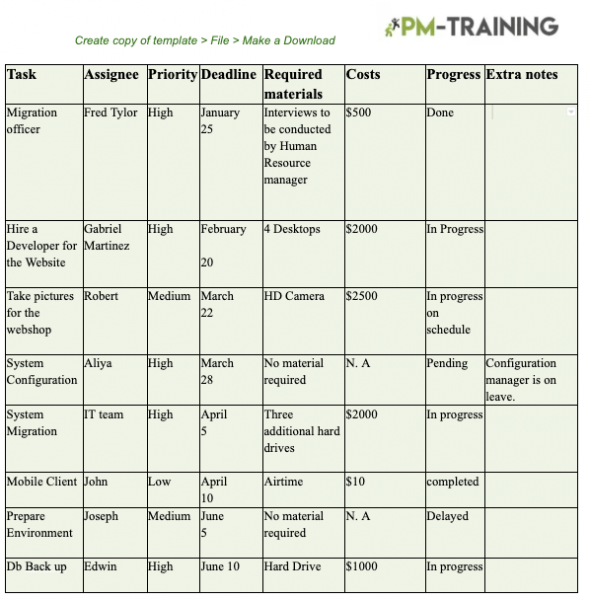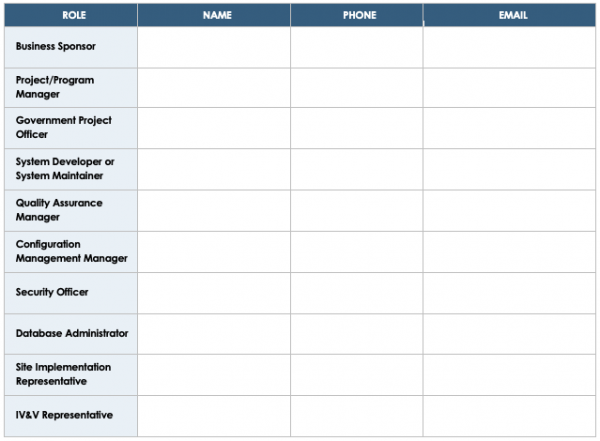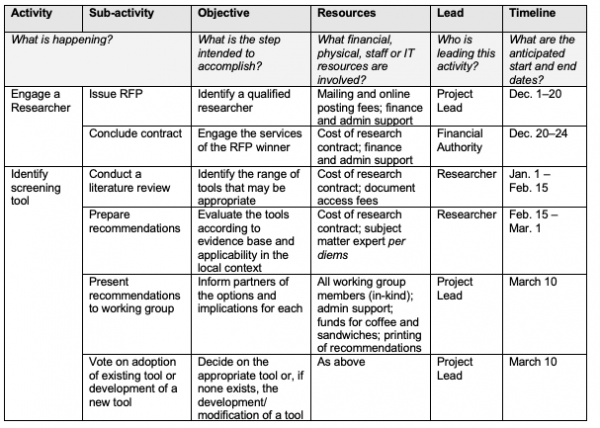An implementation plan, also referred to as a strategic plan, highlights the combinations of action, process, and strategy that a team should take when accomplishing a shared objective or goals.
An implementation strategy is done at the organizational level to show the company’s strategic direction and resource allocation to make the strategy work.
That way, a strategic plan traces the borders of that and prepares how to implement a strategic plan. It should be in the best possible way from the beginning and how to manage it effectively as it is being implemented.
A strategic plan is presented chiefly as a written document or discussed in project management meetings. The implementation plans are comprehensive and complex and should contain answers for budgets, tasks and subtasks, collaborators, timelines, and any additional resources.
Features of Implementation Plan
Integrated Process. It means that various activities that make up an implementation strategy are interdependent. An example of those activities is the business promotional strategies.
Action Oriented. An implementation strategy should be practical. You can only achieve practicability through management processes such as organizing and planning. The management is responsible for developing a plan and making it worthwhile.
Varied skills. Vast knowledge, organizational skills, positive attitude, and abilities are needed to implement a strategy. Competence in these skills is vital in resource allocation, designing structures, and making policies.
Wide scope. A strategic plan covers a broad area of managerial and administrative activities. For example, suppose you aim to execute a marketing strategy. In that case, you must have a marketing budget, do market research, have a promotional plan, carry out market testing, introduce the product and evaluate customer reviews.
On the other hand, the implementation process is the strategic approach that enables organizations or businesses to embrace new procedures. Organizations implement new strategies for various reasons, including promoting efficiency, directing business growth, streamlining tasks, or reducing errors.
An implementation process has guidelines for delivering and accomplishing new tasks in a business that lay steps for work daily. The implementation process is a critical component of management. It is a vehicle for positive change used by the head of departments in an organization when the status quo distracts business productivity. Generally, management uses an implementation process to execute strategies. It answers who, where, when, and how to meet targets.

Components of the Implementation Strategy
It is essential to know how to create your implementation strategy by ensuring you include all the components. Although no standard components fit all when creating an implementation strategy, the following are the components you should have.
Project Objectives and Goals
You should list your project objectives in the first stage of the implementation strategy. Define your goals and indicate the benchmark your team will use to measure and monitor the progress. Having a clear objective and your team will be able to gauge your progress and performance going forward.
Scope Statement
Outline your scope statement in the second stage of your implementation strategy. The project scope statement highlights your project boundaries and indicates what goals, deadlines, and outcomes of the project you will be working on. Stating your project scope in the strategic plan will prevent unrestrained growth in the project scope after the project kicks off.
Outline Deliverables
These are your project’s tangible goals. Stating the deliverables will help you allocate resources, delegate tasks, and manage time frames.
Implementation Timeline
As you carry on with your project, the project timelines may differ, but it is essential to indicate your expected completion dates when drafting an implementation strategy. All implementation strategies should have well-elaborated timelines to be carried out correctly. Often, people use Gant Charts for implementation planning because they display information in a linear path comparable to a timetable.
Risk Assessment
You can use a contingency plan, SWOT analysis, or risk register to identify risks, but this document should be part of your plan. With a risk assessment, other team members can go through your findings and assist you in preventing potential risks.
Team Roles and Responsibilities
You should allocate roles and responsibilities to your team members to hold everyone accountable for their actions. No matter the method you use to indicate the team roles in your plan, you should have a space where a member can refer in case of a question.
When Do You Begin Implementation Planning?
Always be on time when you begin your implementation strategy, not too early or too late. The reason is that the implementation strategy process takes time.
Most tasks needed in strategic planning entail waiting on approval and communication from different stakeholders. It also needs goal setting, lots of research, defining and gathering resources, and ensuring the team to carry the task is available.
You should not plan too early; instead, you should wait until there is a green light on the project. For instance, start planning only after the contract is signed and a deposit has been made.
After you have exhausted the client onboarding duties, you can kick off the implementation strategy. Remember that these plans are mandatory before you begin a project, so have a system to start and aid the implementation strategy.
How to Write an Implementation strategy?
The following are steps to use when developing an implementation strategy.
Define Goals
The first step is defining what you hope to achieve when you complete your project. For instance, do you want to want to revive your external content strategy, or do you want to gain new clients from marketing?
Conduct Research
After identifying your goals, sharpen them by doing research such as focus groups, observations, surveys, or interviews. You should conduct your research from experts in your field, who may be external stakeholders or team members. The following questions should guide you at this stage.
• What teams should accomplish the strategic goals?
• How long will it take to accomplish the strategic goals?
• How much should be allocated from the resource and budget?
Map out Risks and Assumptions
After brainstorming the potential risks in your implementation strategy, you should map out all those possible risks you may encounter in your project. That may include holidays, paid time off, losing personnel, budget constraints, or market instability. You can do risk analysis or SWOT analysis to identify any threat to your project.
Schedule Milestones
These are the checkpoints that help you track your project progress. Milestones act as metrics to measure how far you are in your project and what is remaining to complete it.
Use the Gantt chart to check the project’s progress and ensure every team member performs their tasks. A Gantt chart can outline your implementation schedule and indicate the timeline of each project.
You should also consider:
• Wiggle room. Not everything will fall on its timeline, even if you apply all the resources. A wiggle room in your schedule ensures the projects remain on track instead of fixing them in tight deadlines, and you fail to achieve them.
• Indicate dependencies. These are tasks that their completion depends on other tasks.
Assign Responsibilities and Tasks
Every plan must have team members assigned their responsibilities. Allocating duties will help you assess your team members and their progress. You can use project planning software to ensure that all systems work correctly and trace individual productivity.
Allocate Resources
One of the best ways to mitigate risk is the allocation of resources. If you figure out the things you need for your project and ensure they are available, you eliminate the risk of running short of resources halfway into the project.
Implementation Plan Template Google Doc
The objective of this project and the implementation plan template was to develop a unique single central storehouse to store and maintain clients’ information and interaction details with the company directors. The project’s primary goal was to keep a customer database so that every executive could keep up with the client’s last interactions and continue with the conversation from where they left last.

Examples of the Implementation strategy
Every day different companies use implementation strategies daily. The following is an implementation strategy for a software development team creating a new app.
Project objective and goal– Design a new app.
Objectives– These are all the steps to achieve the final goal.
Success Criteria– There needs to have communication between the project stakeholders and the development team to discuss the success benchmark.
Scope Statement– The development team will record all the work required to generate the app at this stage. The group divides the project into tasks referred to as user stories in software development. It must also list all things it won’t handle, i.e., the exemptions.
Resource Plan– The team will require all the equipment and the professionals participating in the software development process.
Risk Analysis– Using different risk analysis methods, the product manager will list all possible risks that may hinder the app development process.
Timeline, Metrics, and Milestones– The project team can use the Gantt chart to develop an implementation strategy timeline.
Team roles and responsibilities– Using a Kanban board, the project manager allocates implementation strategy tasks to the project team depending on their roles and responsibilities.
Benefits of an Implementation Strategy
The following are benefits of the implementation strategy
Improved Quality of Output
The implementation strategy gives a standardized work procedure. That will ensure the quality of outputs remains by eliminating the risk of teams making mistakes that affect the quality of final products.
Increases Efficiency
Repetitive processes streamline repetitive tasks. That will enable efficient use of labor and allocation of resources. A well-organized process reduces time spent on monotonous tasks and allows employees to do more on other jobs.
Ensure Scalability
An implementation strategy makes scaling easier. It may be easy to complete tasks organized when the business is small, but jobs requiring coordination from different people may require an action plan.
Aids Transparency and Compliance
An implementation strategy will ensure proper documentation, which is ideal when complying with corporate laws and standards. A plan is also crucial since they enable employees to see how the results come about.
Easier Monitoring of performance
It is easier to measure the process using objectives and key performance indicators to evaluate implementation success.
FAQs
What are the four major components of the Implementation strategy?
Work planning
Planning the tasks and subtasks
Time planning
Team roles and resource planning
What is the Purpose of the Implementation Strategy?
An implementation strategy, also referred to as a strategic plan, highlights the combinations of action, process, and design that a team should take when accomplishing a shared objective or goals. It covers all project aspects, including personnel, timeline, and budget.
What is the difference between an action plan and an Implementation strategy?
An action plan focuses mainly on outlining the work task and packages. On the other hand, the implementation strategy is more comprehensive and describes other undependable factors that influence the implementation process, e.g., team roles and responsibilities, resources, and risks.
What is an Implementation strategy in project management?
An implementation strategy in project management is a tool that enables project managers to manage small tasks that fall within their project plan. The plan will help them allocate functions to their members for easier management and effectiveness. It should allow them to execute the plan to completion without too much hustle.


